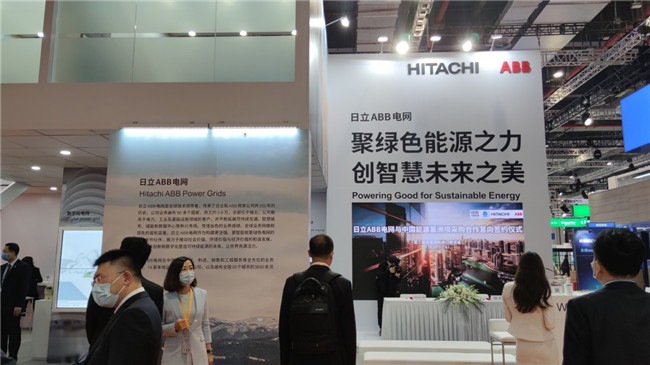MNCs see huge growth opportunities from changing energy patterns

Visitors pass the Hitachi ABB power grid booth at the third China International Import Expo in Shanghai on Nov 6. [Provided to China Daily]
China's aim to achieve carbon neutrality by 2060 will create the most market opportunities for those multinational companies that adjust to fit into the country's low carbon energy structure.
Total China Country Chair William Zhao said China is sure to be less reliant on coal and increase the weighting of natural gas and other renewable energies in its power structure. Given China's rising investment in wind and photovoltaic power generation, it has already teamed up with Shanghai-based Envision Group in mid-2019 to tap into the distributed photovoltaic market in the country. In late 2020, Total's wholly owned subsidiary Saft opened a new manufacturing hub for energy storage solutions in Zhuhai, Guangdong province, which will support the transition to renewable energy.
"While China is advancing its transformation in energy consumption, Total will accelerate the exploration of the Chinese market and get more deeply rooted by working more closely with our Chinese partners," he said.
Metals and mining corporation Rio Tinto announced in late 2020 a partnership with China Baowu Steel Group and Tsinghua University to try out new techniques and lower carbon emissions in the steel industry. It will also invest $10 million in the next two years to conduct research into low-carbon iron-making with Baowu.
According to Peter Toth, group executive of strategy and development at Rio Tinto, global cooperation will best address the challenges created by climate change. China's carbon neutrality process will help the world to realize carbon emissions goals, resulting in changes in demand for commodities, driving the development and application of new technologies and creating more cooperation opportunities, Toth said.
Coating giant Nippon Paint has made great efforts to build green factories across China, which feature efficient use of land, more environmentally friendly raw materials, clean production, waste recycling and low carbon emissions. The company has so far set up such green factories in Xianning, Hubei province, Qingyuan, Guangdong province, Changsha, Hunan province, Shijiazhuang, Hebei province and Quanzhou, Fujian province. By the end of last year, three of its plants were included on the green manufacturing list compiled by the Ministry of Industry and Information Technology as national-level green factories.
Xing Ronghua, president of the production and supply chain division for trade unit at Nippon Paint China, explained, a comprehensive production and supply mapping can help facilities nationwide use raw materials more efficiently and shorten transportation distances, which in turn can reduce carbon emissions throughout production and delivery. By applying a smart manufacturing system, energy management can be seamlessly connected to production procedures so that carbon emissions are reduced.
"Together with our parent company Nipsea Group, we will continue to promote green and eco-friendly ideas and practices as long-term and sustained development is the ground rule that Nippon Paint China has adhered to," Xing said.
The facility built by L'Oreal in Yichang, Hubei province, realized zero net carbon emissions in September 2015. The plant started to recycle water for production purposes in October last year. The factory can help save 16,000 tons of tap water annually-an amount equal to the water used by 93 families in 12 months.
As early as June 2019, the French cosmetics giant announced that it had achieved carbon neutrality in China. According to L'Oreal China Vice-President Lan Zhenzhen, the company had broken down the goal into quantifiable gauges and rebuilt the work patterns to lower environmental impact throughout the entire value chain.
A special sustainable development team has been set up to make short to midterm plans and release to the public any updates.
Suppliers are also included in L'Oreal's sustained development path in China, Lan said. Third-party platforms are involved to provide evaluation and training for suppliers to help lower negative impact on the society or the environment. Consumer education is carried out so that consumers, especially the younger generations, can consume in more responsible ways and lead more sustainable lifestyles.
"Our fiscal results in China over the past decade show that business growth can go hand in hand with sustainable growth targets," she said.
Yvonne Zhou, managing director of global consulting firm BCG, said that China's carbon neutrality goal may lead to a large number of opportunities for companies. On the one hand, they should find where their own carbon emissions lie and make efforts to go greener.
On the other, they should look into their respective industries. The construction industry for example has become more industrialized, digitalized and greener. Instead of aiming for growing bigger in scale, a construction company operating in China should focus more on reducing waste, using low-carbon materials and developing new business models.
"Apart from allowing business to grow, companies should think outside the box and experiment with new models," she said.


 China's public holidays for 2025
China's public holidays for 2025  Shanghai FTZ: Go all out to build China's first pilot zone for Silk Road E-commerce cooperation
Shanghai FTZ: Go all out to build China's first pilot zone for Silk Road E-commerce cooperation  Favorable policies boost 'China Travel' trend
Favorable policies boost 'China Travel' trend  play
play 